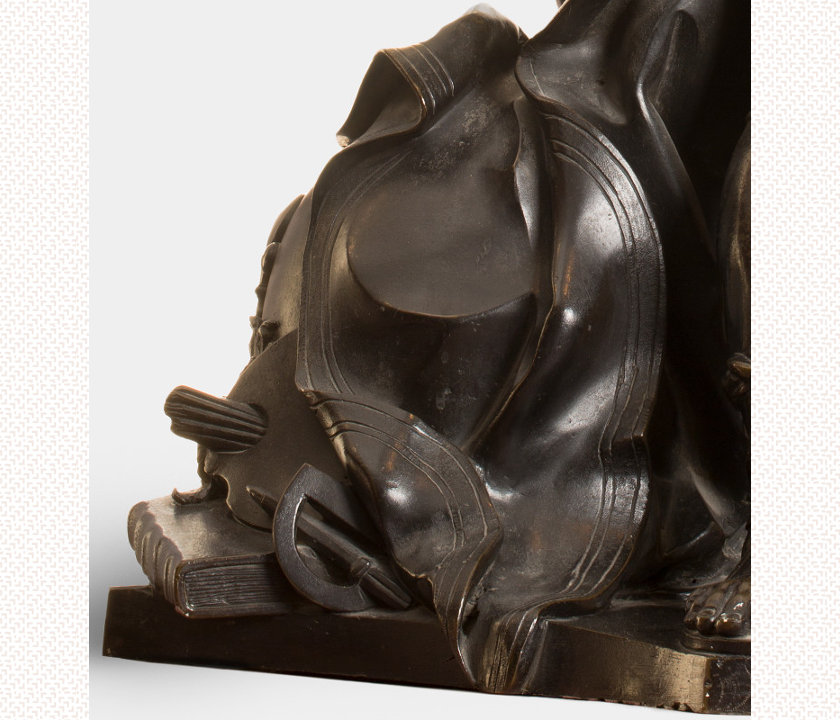Dieudonné-Barthélémy Guibal (1699, Nîmes –
1757, Lunéville)
Paul-Louis Cyfflé (1724, Bruges –
1806, Ixelles-les-Bruxelles)
1750
Bronze moulé en ronde bosse
H. 84 ; L. 67 ; Pr. 38 cm
Inv. 61.16.1
Achat à la princesse de Faucigny-Lucinge et Coligny, 1961
In 1751, Stanislas had a square built in Nancy dedicated to the glory of his son-in-law Louis XV, modelled on the French royal squares.
At the centre of the architectural scheme designed by Emmanuel Héré, a monumental statue of the King of France was commissioned from the sculptors Dieudonné-Barthélémy Guibal and Paul-Louis Cyfflé. A wax model was first presented to the king of Poland by Guibal, then cast in bronze four years later in Lunéville by Perrin. The statue, measuring 4.66 m in height, was then transported to Nancy, where it was unveiled with great fanfare on 26 November 1755 in the Place Royale.
The monarch is depicted standing, dressed in an antique costume and holding the baton of command in one hand, with his face turned towards the west, i.e. towards France. The work was inspired by models created a century earlier for Louis XIV by Desjardins and Coysevox, and follows on from the pedestrian statues of Louis XV erected in Bordeaux, Rennes and Valenciennes a few years earlier. At the king's feet are a globe adorned with fleurs-de-lis, a helmet crowned with laurels and attributes of the arts. The base is composed of a pedestal bearing a hexameter on each side to the glory of the king of France and a pedestal in Genoa marble adorned with four scrolls in the corners. Four medallions in relief depict the marriage of Louis XV and Marie Leszczynska, the Peace of Vienna, the taking of possession of Lorraine and the founding of the Stanislas Academy. Finally, Prudence, Justice, Valour and Clemency, the four virtues associated with the figure of the King of France, flank the lower part of the pedestal.
The whole was destroyed in 1792 during the revolutionary period and replaced in 1831 by a statue of Stanislas created by Georges Jacquot. The original work is only known from engravings and drawings, and from the reduced bronze version that adorned the ground-floor salon of Chanteheux's royal pavilion in 1752, and which was perhaps one of the preparatory models for the monumental work.

![[Translate to English:] Dieudonné-Barthélémy Guibal et Paul-Louis Cyfflé, Modèle de la statue de Louis XV, bronze moulé en ronde bosse, 1750](https://musee-lorrain.nancy.fr/fileadmin/_processed_/c/6/csm_image_src_louis.xv_66c7e7cc67.jpg)
![[Translate to English:] Dieudonné-Barthélémy Guibal et Paul-Louis Cyfflé, Modèle de la statue de Louis XV, bronze moulé en ronde bosse, 1750](https://musee-lorrain.nancy.fr/fileadmin/_processed_/7/5/csm_image_src_louis.xv.1_4895bb9d61.jpg)
![[Translate to English:] Dieudonné-Barthélémy Guibal et Paul-Louis Cyfflé, Modèle de la statue de Louis XV, bronze moulé en ronde bosse, 1750](https://musee-lorrain.nancy.fr/fileadmin/_processed_/b/d/csm_image_src_louis.xv.2_3bbcef2164.jpg)
![[Translate to English:] Dieudonné-Barthélémy Guibal et Paul-Louis Cyfflé, Modèle de la statue de Louis XV, bronze moulé en ronde bosse, 1750, détail](https://musee-lorrain.nancy.fr/fileadmin/_processed_/c/5/csm_image_src_louis.xv.3_c5d291b42e.jpg)
![[Translate to English:] Dieudonné-Barthélémy Guibal et Paul-Louis Cyfflé, Modèle de la statue de Louis XV, bronze moulé en ronde bosse, 1750, détail](https://musee-lorrain.nancy.fr/fileadmin/_processed_/2/0/csm_image_src_louis.xv.4_e344746233.jpg)

